Interviews
dslcollection.
An interview with Sylvain Levy.
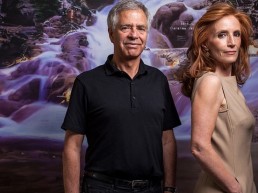
"Artworks in the collection may be characterized as disruptive, hard to explain, seductive, beautiful, unique and challenging. dslcollection is focused on the acquisition of monumental works with powerful visual effects. The choice of monumental works is linked with the idea of viewer contemplation and immersion. To use a concept dear to German aesthetics: A great artwork is a total work."
You have described yourself as an “entrepreneurial collector”. What does this term mean to you and how does it define your collecting activities?
What does being an entrepreneurial collector mean for me? He/she is someone with a vision and in our case it is about building a timely and timeless cultural brand. He/she has to be always on the move and to constantly adapt to time. Craziness is an important part of an entrepreneurial spirit, and especially to think “out of the box”. Thus by focusing the collection only on Chinese contemporary art, dslcollection has deliberately positioned itself “out of a comfort zone”.
Entrepreneurship is also about the creative and strategic process with which one effectively and sustainably translates a story to the largest possible audience.
You have said your interest in Chinese contemporary art started when visiting your brother-in-law in China but how exactly? Was there one specific work which specifically sparked your interest, or a moment which made you point your collecting firmly in this direction?
Two encounters sparked our interest in Chinese contemporary art. The first one was Lorenz Helbling from Shanghart gallery. He opened his gallery in 1992 and today he is among the leading gallerists in Chinese contemporary art. He took us to visit Ding Yi‘s studio. We were quickly seduced by Ding Yi’s works because as Lorenz said, “Over the years Ding Yi has developed a painterly language for our complex time, avoiding cliches of east and west, old and new.” That is why we decided to collect his work, which then was the first one in dslcollection.
What inspired us? We believe that art is one of the mirrors of a society. Chinese contemporary art is radical — not only relative to an inward-looking Western canon, but also to traditional Chinese art history, its sensibilities and methods. Chinese contemporary art confronts both. We collect Chinese contemporary art not as an identity, but as a matter of subject. It is provocative, challenging, and deeply rewarding.
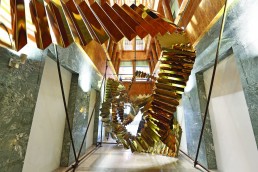

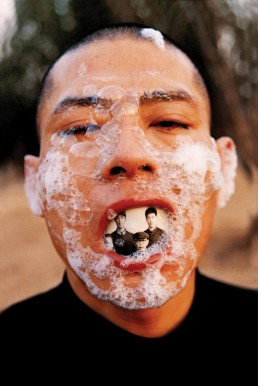
How different is the contemporary Chinese art market compared to the European one? How would you sum up these differences?
The difference between the two markets is essentially a difference in maturity. Another main difference between them stems from the fact that most Chinese artworks remain within the Asian market; there is less international demand for them. One should not neglect also the fact that the Chinese government has a major say in developing art in the country, but in the meantime we can already see an important private museum sector developing in China to meet a growing demand for art.
You have spoken about how the development of China is changing the World, and the digital revolution is changing mankind. How would you like the development of your collection to summarize these observations?
Today technology is increasingly more embedded with our daily lives. Consequently dslcollection is an ongoing cultural and entrepreneurial project that embodies a family adventure and a collection of art and science. dslcollection acts like an organization designed to search for a model emphasizing on nimbleness. We do not want to be just a smaller version of the present “bricks and mortar” museum model. Opening the virtual collection obliged us to fix new metrics of success not only related to numbers, but on the quest of being authentic, influential, close to people, and to be visible. Embracing a human-centered mindset in museums prompted us to advance concepts of empathy and connection as integral elements to our collection’s values and culture.
You’ve said at various times that you don’t have a favorite artwork as each of them is a chapter from the journey you and your wife are taking in contemporary art but is there one that stands out in some way because of the story around it?
It is perhaps Jia Aili’s “Our Century” painting. It is a 6 by 15 meters artwork that took 7 years to be completed. The whole process is also documented by sketches, photos and videos.
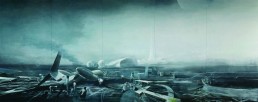
Given that you often collect very large and museum quality works how do you manage to enjoy them in person, and what do you consider to be the best way to share your collection with the art community at large? Does a collector on your scale have a responsibility to the art community and how would you describe this?
dslcollection is focused on the acquisition of monumental works with powerful visual effects. The choice of monumental works is linked with the idea of viewer contemplation and immersion. To use a concept dear to German aesthetics: A great artwork is a total work. dslcollection is a collection of artworks not artists. If a work is considered breath-taking and meaningful, it will be collected. Artworks in the collection may be characterized as disruptive, hard to explain, seductive, beautiful, unique and challenging. They must exemplify an artistic moment. As a private collection, we believe that more than having a responsibility, it is essential (since we decided to open the collection to the public) to be influential and accessible to the people. Accessibility is also about being empathetic.
"To collect you must first be a humanist."
You have said that you refresh your collection through the annual de-acquisition of around 15% of its number. You work with the galleries and through private sales and never auctions to sell some of it and then you acquire new ones to keep a constant number of 350 pieces. Tell us a bit more about this policy and this method.
dslcollection has conceptualized the building of the collection by limiting the number of works to 350 works, adding and subtracting 10% of the works every year to constantly keep it contemporary. An organic collection that consistently renews itself by a self-imposed limitation, vigorously edited to reflect the changing times and tastes of the owners. It follows also the “ Non Finito Spirit” of Michelangelo and Rodin, which is about unfinished works and the refusal of the sole quest of perfection. Usually we go back to the galleries to make these exchanges or use private sales.
How do you see the future of the collection? What digital ways do you think you can embrace to develop the mission of your collection.
dslcollection wants to establish a model that makes collecting art continuously active and meaningful, always moving with the shifting times. These times can be characterized by diverse challenges: volatility, complexity and uncertainty. Agility and bravery are ways to respond to these times. It must constantly create openness to others, questioning society and the circulation of ideas.
A collection should use all the digital tools to reach a wider audience, and to be open to global and contemporary issues, but also in reverse; to use it to constantly collect new ideas and feedbacks in pursuit of perfection.
The collection should fully be managed according to its resources and realities. The technology is now in place to allow smaller entities to compete with, and to complement, larger institutions, without the bureaucracy or need for large financial investment.
Can a collection remain active in the contemporary context and in the future outlive the passing of their namesake founders? To make this possible, we have to engage in a manner that is both timely and timeless. To pursue timelessness alone would mean existing only in the traditional sense of a collection: accumulating works and maintaining them in a static manner, irrespective of shifting concepts and new developments. To be only timely would mean becoming ephemeral or subsumed in what is an increasingly crowded competitive milieu. Cultural institutions of the future will be mutable, physical and virtual entities, evolving from places of art storage and preservation to sites of ongoing knowledge production and exchange. But one has to always remind oneself of how close opportunities and risks are in our current world of globalization, digitization and acceleration.
Never forget: Art history is brutal: very little will remain.
"Never forget: Art history is brutal: very little will remain."
You are very proactive with the tools the internet offers. What is your view of the way Artland seeks to share exhibitions around the world with its community through the 3D recordings it makes? Can you imagine a time when this will be a significant way to discover new things?
Born into a screen-based world, today’s new generation moves in and out of the physical and virtual worlds at ease, believing that each world is ‘real’ to them. The digital tools have opened alternative realities that are as important as the reality. From 2005 we went from a website to a 2D and 3D museum, and in 2012, a museum on Second Life and now, augmented reality and virtual reality. We were among the first one to build a VR museum two years ago. As emphasized by a research professor Paul Verschure, a virtual museum complements and enhances the museum experience “through personalization, interactivity, and richness of content.” Therefore, the ontology, perception and dissemination of artworks are being renegotiated with the use of virtual reality. We have been showing our portable museum in many different types of events. We were surprised by the reactions of old people and by the young audience.
As for the old people already in Europe, every 5th person is now over 65 years old. The new and the fresh is very much appreciated by those whose daily lives could be quite uneventful. It opens a new world for them with just a simple mask.
VR escapism allows seniors, the sick, or disabled people to stay at home and travel anywhere, visiting exhibitions in New York, Paris or Shanghai.
As for the young generation who is not interested primarily by art, they can connect with it through the use of gamification art contents. Generation Z teenagers are now “hanging out” with each other, having conversations and social interactions with their local and international friends within virtual gaming worlds, such as Fortnite.

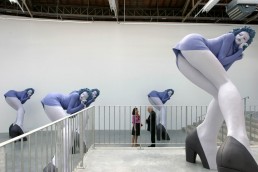

You have said that you believe it is important for a collector to develop a focus of their collection, and that they should also be challenged. What other advise would you give to someone who is trying to develop a collection.
I am always reluctant to give advice because a collection is a personal adventure and all the reasons that make someone collect have to be respected.
To collect you must first be a humanist. Be close to the galleries and the artists and especially support your own art scene. Do not be afraid of making mistakes. Do not regret the works you have missed. Find your niche. A collection needs a vision and time. A collection should strike by its density, the message that it delivers about ourselves, about an epoch. A collection must be strong, disturbingly unconventional. The worst is immobility, it is not to evolve. Taste, curiosity, intelligence must continually guide the collector to new shores and experiences. The most important: Make yourself happy: Collecting can give an ordinary person an extraordinary life.